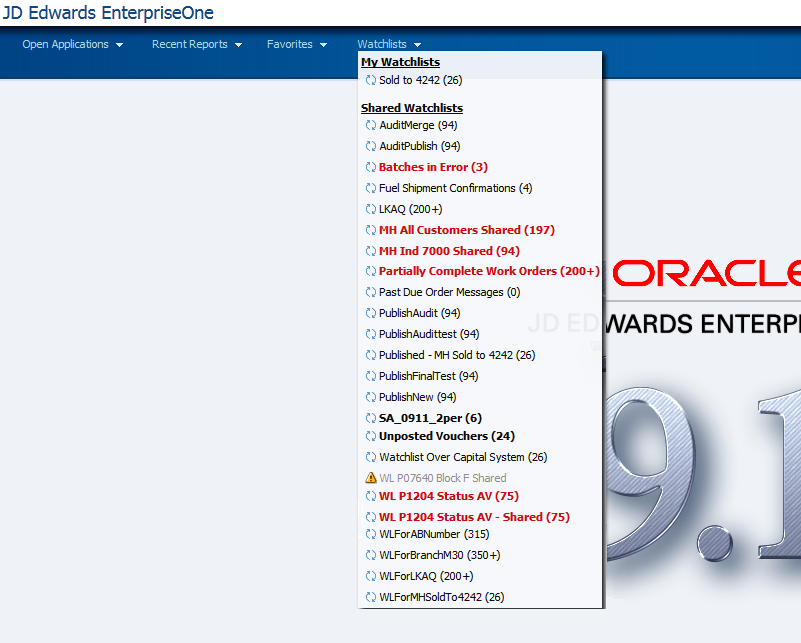1 Understanding One View Watchlists
This chapter contains the following topics:
1.1 One View Watchlists Overview
One View Watchlists represent collections of items that match user-defined criteria. They enable users to define information to which they would like to be alerted. For example, a user might want to be alerted to outstanding tasks that they need to do or thresholds that have been passed. Watchlists provide an easy way for this information to be conveyed to users.
If there are existing Watchlists to which you have access, you will see the Watchlists menu on the menu bar within JD Edwards EnterpriseOne. When you select the Watchlist menu, a list of existing Watchlists appears. Each Watchlist represents a collection of items that match the criteria that were set up for that Watchlist. For example, Watchlists might contain expenses needing approval, batch processes in error, customers over their credit limit, and purchase order receipts past due.
Watchlists are built upon the existing JD Edwards EnterpriseOne query framework and are therefore, only supported on forms that support queries.
1.2 Key Features of One View Watchlists
-
Improve user productivity by pushing data to the end user outside of the application.
-
Enable users to define personalized Watchlists based on a JD Edwards EnterpriseOne application and saved query.
-
Enable users to quickly access information that is important to them directly from their JD Edwards EnterpriseOne home page.
-
Provide advanced options like warning thresholds, refresh intervals, and maximum record counts.
-
Enable an administrator to secure which users can view, create, and share Watchlists.
1.3 Shared and Personal Watchlists
One View Watchlists are classified as either shared or personal. Shared Watchlists are available systemwide unless they are restricted by security settings. Watchlists that you create are classified as personal Watchlists and appear under My Watchlists on the Watchlists menu. Personal Watchlists are available only to you. However, you may have the option to publish a personal Watchlist to share it. This option is not necessarily available to every user because permission to share a Watchlist must be granted by an administrator.
When you publish a Watchlist, the personal copy of the Watchlist is maintained and is completely separate from the shared Watchlist. The two Watchlists both appear on the Watchlists menu, one under the My Watchlists section and one under the Shared Watchlists section.
1.4 Viewing One View Watchlists
Once Watchlists have been created and if you have been permitted access, you will see the Watchlists menu on the JD Edwards EnterpriseOne menu bar. Within the Watchlist menu, you find Watchlists that you have created under the ”My Watchlists” heading. Shared Watchlists to which you have access appear under the ”Shared Watchlists” heading.
|
Note: Security options are available to prevent users from viewing or creating Watchlists. If Watchlist security has been implemented, you may not see some or all shared Watchlists or be able to create your own Watchlists.See the JD Edwards EnterpriseOne Tools One View Administration Guide for more information. |
The first time you open the Watchlists menu, the system will update the Watchlists with the most current information. The frequency of updates after that is determined by how the Watchlist was defined. However, you can use the Refresh icon in front of the Watchlist name to recompute the Watchlist information on demand. You can also hover over a Watchlist to see how long it has been since its last update.
When a Watchlist is defined, a warning threshold and a critical threshold can also be specified for that Watchlist. If a particular Watchlist has surpassed the warning threshold, it appears in bold text within the Watchlists menu. If a Watchlist has surpassed it's critical threshold, it appears in red text.
The number in parenthesis immediately following the name of the Watchlist represents a count of records that meet the query criteria. The number shown in parentheses will never exceed the Maximum Records to Return field defined when the Watchlist was created. It will display the maximum records to return with a plus sign. For example, if there are 63 records representing fuel shipment confirmations and the maximum records to return is set to ”50,” the Watchlist displays as: Fuel Shipment Confirmations (50+). It may also be bold and red depending on the warning and critical thresholds that have been set up for the Watchlist.
|
Note: The critical threshold should be higher than the warning threshold and lower than the maximum records to return in order to be useful. |
Selecting a Watchlist takes you into the application where you can see the items included in the query. Within each application, use the Watchlist Design icon to access the Watchlist Management tab and add, edit, share, or delete Watchlists.
